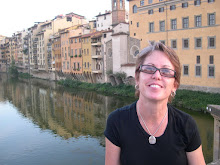The Tate houses several Picasso’s, my favorite being “Nude Woman in a Red Armchair,” of his mistress and muse Mare-Therese Walter (1932).

This work belongs to the remarkable sequence of portraits that Picasso made of Marie-Thérèse Walter in his studio at the Chateau de Boisgeloup. Marie-Thérèse is presented here – as in almost her portraits – as a series of sensuous curves. Even the scrolling arms of the chair have been heightened and exaggerated to echo the rounded forms of her body. The face is a double or metamorphic image: the right side can also be seen as the face of a lover in profile, kissing her on the lips.
(From the display caption)
A couple of the pieces are unfamiliar to me; earlier works which are sculptural in feel and painted in a much darker palette: “Seated Nude,” 1909-10, and “Bust of a Woman,” 1909.
In the early years of Cubism, Picasso constructed his images using small facets, or geometric planes, and represented objects from different viewpoints. Many critics of the period believed the artist aimed to represent reality in a new, almost scientific manner. However, as this atmospheric painting shows, Picasso could use this technique for expressive ends. Here, the woman has been all but stripped of her humanity and appears strangely mechanistic. At the same time, Picasso demonstrates his awareness of tradition in her pose and in the play of light within the picture.
(From the display caption)

The treatment of the human figure in the Cubist paintings of Picasso and Braque is often reminiscent of sculpture. In this work, made in mid-1909, Picasso used planes of warm greys and burnt sienna to establish the bulk of the body. The shifting directions of the brushstrokes indicate the depth of the surfaces and enhance individual features such as the conical socket of the eye. Such techniques were inspired by African sculptures. The poet André Salmon described Picasso’s studio as filled with the ‘strange wooden grimaces... [of] a superb selection of African and Polynesian sculpture’.
(From the display caption)
There are also many modern installations and we have a debate regarding what constitutes “art.” While I try to be open-minded, there are some things I don’t necessarily consider art just because someone had the idea to do it and put it on a museum wall. If everything is art, then nothing is art. Take this piece by Michelangelo Pistoletto for example. Is this art? Perhaps. Or, perhaps the real “art” of this piece is the words necessary to explain it and convince the observer of its value. It’s a good thing art is in the eye of the beholder. Go to the Tate website for commentary on this piece.
 |
| Venus of the Rags |
 |
Staircase III, 2010
|
Okay, I won’t bore you with any more of our museum visit; although there was some pretty interesting stuff, especially an installation about Vito Acconci’s 1972 live performances in a New York gallery, particularly that entitled Seedbed… unbelievable. Really, if someone were to tell you about this you would think they were making it up.
After we left the gallery we grab a late lunch at The Real Greek, which pulls us in by aroma and does not disappoint, and then head across the Millennium Bridge to St. Paul’s Cathedral. Unfortunately, St. Paul’s is closed so we settle for walking and window shopping before we need to head back to rest and freshen up. Tonight we have tickets to see “Billy Elliott” at the Victoria Palace Theatre.
 |
| Millennium Bridge |
For more pictures click here.





No comments:
Post a Comment